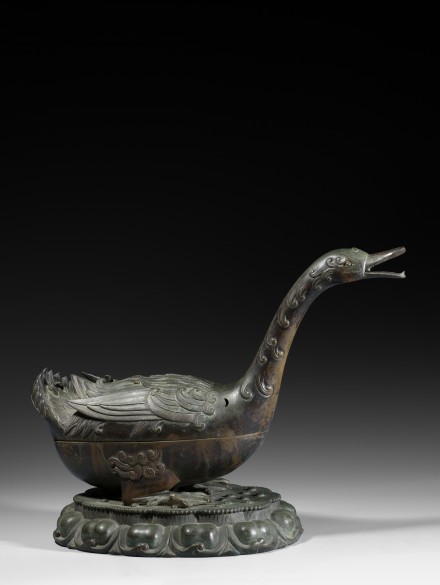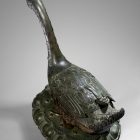J.J. Lally & Co., Oriental Art / New York City, New York
MenuPast Exhibition
ELEGANTLY MADE: Art for the Chinese Literati
March 13-27, 2020

30.
A LARGE BRONZE GOOSE-FORM INCENSE BURNER
Early Ming Dynasty, 14th - 15th Century
elaborately modelled in two sections, the domed upper half of the goose forming the cover, cast in relief with dense plumage all finely detailed and symmetrically arranged, the wings folded back with tips rising in twin points towards the rounded tail, a pair of small crescent-shape apertures on the narrow shoulders to allow for aeration, the long slender neck extended with head held high and beak open to allow the fragrant smoke to escape, embellished with curled feathers along both sides of the neck and a small ruyi-head motif on the forehead, the lower half closely fitted to complete the body of the goose and form a generous firebox for burning incense on the interior, cast on the exterior with clusters of curled feathers on either side above the short legs and webbed feet attached by thick tenons to the original matching bronze in the form of a stylized lotus pod surrounded by a wide border of rounded lotus petal motifs, the rich dark brown patina shading to green and with natural verdigris widely scattered.
Height 14 1⁄2 inches (37 cm)
Length 18 3⁄4 inches (48 cm)
Provenance
Private Collection, California
Bonhams New York, Chinese Art from the Scholar’s Studio, 16 September 2013, lot 8103
J. J. Lally & Co., New York
Shuisongshi Shanfang Collection
This censer is the largest of its kind yet recorded and the only example known which is complete with its original matching base.
A much less elaborately cast bronze censer in the form of a goose with outstretched neck in the collection of the Victoria and Albert Museum is illustrated by Kerr, Later Chinese Bronzes, London, 1990, p. 82, fig. 62, attributed to the Song dynasty, with the comment that similar censers have been excavated from Song tombs, supported by a footnote reference of a smaller bronze censer in the form of a duck excavated in Jishui, Jiangxi province, from the tomb of Zhang Xuanyi (d. 1237), published in Wenwu, 1987, No. 2, pp. 66-67 in a line drawing showing the bird’s body divided into two sections in a box and cover model similar to the present example. Kerr also mentions, op. cit., p. 80, the fact that Chinese bronze censers in animal forms were exported to Japan during the Yuan and Ming and cites as an example a Chinese duck-form censer on a rectangular plinth imported to Japan during the Ming dynasty and now in the Tokugawa Museum of Art, published in the catalogue, The Shogun Age Exhibition, Tokyo, 1983, p. 107, no. 75.
A large gilt bronze goose-form incense burner very similar in form and design to the present example, but lacking the original base, was sold at Christie’s New York 29 March 2006, lot 320 and the same goose-form censer was sold again at Poly Auction in Hong Kong 4 December 2014, lot 5632.
Compare also the smaller gilt-bronze incense burner in the form of a duck from the Speelman Collection inscribed with a credible Xuande reign mark (1425-1435) sold at Sotheby’s Hong Kong 4 April 2014, lot 85.
明初十四 – 十五世紀 銅雁形蓮座香薰 高 37 厘米 長 48 厘米
來源 加州私人收藏
紐約邦瀚斯 2013 年 9 月 16 日,拍品第 8103 號
紐約藍理捷中國文物
水松石山房藏
Additional Images (Touch to enlarge)
30.
A LARGE BRONZE GOOSE-FORM INCENSE BURNER
Early Ming Dynasty, 14th - 15th Century
Height 14 1⁄2 inches (37 cm)
Length 18 3⁄4 inches (48 cm)
